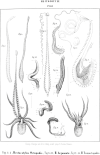Deciphering regeneration through non-model animals: A century of experiments on cephalopod mollusks and an outlook at the future
- PMID: 36699008
- PMCID: PMC9868252
- DOI: 10.3389/fcell.2022.1072382
Deciphering regeneration through non-model animals: A century of experiments on cephalopod mollusks and an outlook at the future
Abstract
The advent of marine stations in the last quarter of the 19th Century has given biologists the possibility of observing and experimenting upon myriad marine organisms. Among them, cephalopod mollusks have attracted great attention from the onset, thanks to their remarkable adaptability to captivity and a great number of biologically unique features including a sophisticate behavioral repertoire, remarkable body patterning capacities under direct neural control and the complexity of nervous system rivalling vertebrates. Surprisingly, the capacity to regenerate tissues and complex structures, such as appendages, albeit been known for centuries, has been understudied over the decades. Here, we will first review the limited in number, but fundamental studies on the subject published between 1920 and 1970 and discuss what they added to our knowledge of regeneration as a biological phenomenon. We will also speculate on how these relate to their epistemic and disciplinary context, setting the base for the study of regeneration in the taxon. We will then frame the peripherality of cephalopods in regeneration studies in relation with their experimental accessibility, and in comparison, with established models, either simpler (such as planarians), or more promising in terms of translation (urodeles). Last, we will explore the potential and growing relevance of cephalopods as prospective models of regeneration today, in the light of the novel opportunities provided by technological and methodological advances, to reconsider old problems and explore new ones. The recent development of cutting-edge technologies made available for cephalopods, like genome editing, is allowing for a number of important findings and opening the way toward new promising avenues. The contribution offered by cephalopods will increase our knowledge on regenerative mechanisms through cross-species comparison and will lead to a better understanding of the complex cellular and molecular machinery involved, shedding a light on the common pathways but also on the novel strategies different taxa evolved to promote regeneration of tissues and organs. Through the dialogue between biological/experimental and historical/contextual perspectives, this article will stimulate a discussion around the changing relations between availability of animal models and their specificity, technical and methodological developments and scientific trends in contemporary biology and medicine.
Keywords: arm; cellular and molecular pathways; hectocotylus; history of science; invertebrates; octopus; pallial nerve; regeneration.
Copyright © 2023 De Sio and Imperadore.
Conflict of interest statement
The authors declare that the research was conducted in the absence of any commercial or financial relationships that could be construed as a potential conflict of interest.
Figures



Similar articles
-
Cephalopod Tissue Regeneration: Consolidating Over a Century of Knowledge.Front Physiol. 2018 May 23;9:593. doi: 10.3389/fphys.2018.00593. eCollection 2018. Front Physiol. 2018. PMID: 29875692 Free PMC article. Review.
-
Molecular Determinants of Cephalopod Muscles and Their Implication in Muscle Regeneration.Front Cell Dev Biol. 2017 May 15;5:53. doi: 10.3389/fcell.2017.00053. eCollection 2017. Front Cell Dev Biol. 2017. PMID: 28555185 Free PMC article. Review.
-
Imaging Arm Regeneration: Label-Free Multiphoton Microscopy to Dissect the Process in Octopus vulgaris.Front Cell Dev Biol. 2022 Feb 4;10:814746. doi: 10.3389/fcell.2022.814746. eCollection 2022. Front Cell Dev Biol. 2022. PMID: 35186930 Free PMC article.
-
E Pluribus Octo - Building Consensus on Standards of Care and Experimentation in Cephalopod Research; a Historical Outlook.Front Physiol. 2020 Jun 19;11:645. doi: 10.3389/fphys.2020.00645. eCollection 2020. Front Physiol. 2020. PMID: 32655409 Free PMC article. Review.
-
From injury to full repair: nerve regeneration and functional recovery in the common octopus, Octopus vulgaris.J Exp Biol. 2019 Oct 9;222(Pt 19):jeb209965. doi: 10.1242/jeb.209965. J Exp Biol. 2019. PMID: 31527179
Cited by
-
SlugAtlas, a histological and 3D online resource of the land slugs Deroceras laeve and Ambigolimax valentianus.PLoS One. 2024 Oct 22;19(10):e0312407. doi: 10.1371/journal.pone.0312407. eCollection 2024. PLoS One. 2024. PMID: 39436899 Free PMC article.
-
Transcriptome-wide selection and validation of a solid set of reference genes for gene expression studies in the cephalopod mollusk Octopus vulgaris.Front Mol Neurosci. 2023 May 17;16:1091305. doi: 10.3389/fnmol.2023.1091305. eCollection 2023. Front Mol Neurosci. 2023. PMID: 37266373 Free PMC article.
-
Lampreys and spinal cord regeneration: "a very special claim on the interest of zoologists," 1830s-present.Front Cell Dev Biol. 2023 May 9;11:1113961. doi: 10.3389/fcell.2023.1113961. eCollection 2023. Front Cell Dev Biol. 2023. PMID: 37228651 Free PMC article.
-
The salamander blastema within the broader context of metazoan regeneration.Front Cell Dev Biol. 2023 Aug 11;11:1206157. doi: 10.3389/fcell.2023.1206157. eCollection 2023. Front Cell Dev Biol. 2023. PMID: 37635872 Free PMC article. Review.
References
-
- Allcock A. L., von Boletzky S., Bonnaud-Ponticelli L., Brunetti N. E., Cazzaniga N. J., Hochberg E., et al. (2015). The role of female cephalopod researchers: Past and present. J. Nat. Hist. 49 (21-24), 1235–1266. 10.1080/00222933.2015.1037088 - DOI
-
- Allen G. E. (1975). Life science in the twentieth century. New York: John Wiley & Sons.
Publication types
LinkOut - more resources
Full Text Sources

